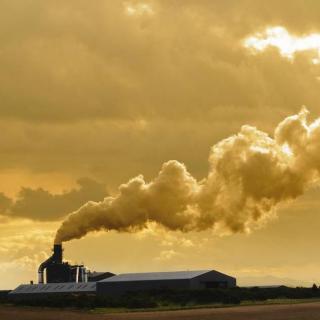
介绍:
想成为我们的主播,欢迎加微信 xdfbook 投稿。
一段美文,一首英文歌,或是一点生活感想,全由你做主。
《应对空气污染,路在何方?》
Is There a Way to Tackle Air Pollution?
A London primary school may issue face-masks to its pupils. The council in Cornwall may take the extreme step of moving people out of houses beside the busiest roads.
Four major cities—Paris, Athens, Mexico City and Madrid—plan to ban all diesels1) by 2025.
Stuttgart, in Germany, has already decided to block all but the most modern diesels on polluted days.
In India’s capital, New Delhi, often choked with dangerous air, a jet engine may be deployed2) in an experimental and desperate attempt to create an updraft3) to disperse dirty air.
The World Health Organization calculates that as many as 92% of the world’s population are exposed to dirty air—but that disguises the fact that many different forms of pollution are involved.
For the rural poor, it is fumes4) from cooking on wood or dung indoors.
For shanty5)-dwellers in booming mega-cities, it is a combination of traffic exhaust, soot6) and construction dust.
In developed countries, it can be a mix of exhaust gas from vehicles and ammonia7) carried on the wind from the spraying8) of industrial-scale farms.
In European cities, where people have been encouraged to buy fuel-efficient diesels to help reduce carbon emissions, the hazard is from the harmful gas nitrogen dioxide9) and tiny specks10) of pollution known as particulates11).
The first step is to understand exactly where the air is polluted and precisely how individuals are affected—and the results can be extremely revealing.
Personal Data
Scientists at the University of Leicester are trailing a portable air monitor to gather precise data at a personal scale.
We watched as volunteer, Logan Eddy, 14, carried the device in a specially adapted backpack that recorded details of the air he was exposed to.
Exactly where he walked was then displayed as lines on an electronic map, the colour of those lines conveying how unhealthy the air was at different points.
It was much worse than WHO guidelines where he had waited to cross a busy junction12), strikingly cleaner in a side-street but then almost off the scale in a sheltered spot beside an arcade13) of shops where a car was parked with its engine idling.
Seeing a graphic display of how pollution can vary so dramatically changed Logan’s view of air, and his friends adjusted their behaviour immediately.
“The people who found out have stopped waiting right near the buses after school for their friends,” he says. “They’ve been waiting … further away from the buses. It’s obviously had an impact on them.”
The personal monitor is one of a range of devices being deployed in Leicester to build up a detailed picture of where pollution hotspots form—and when.
In many cases, they can be short-lived, appearing during rush-hours when traffic jams develop.
For Prof Roland Leigh, of Leicester University, understanding precisely where and when vehicles slow to a crawl or stop will help manage the flow of traffic in a way that minimises the impact on the most vulnerable people—the young and the elderly.
“One of the things we can all do is to improve our transport systems so that our congested traffic is not queued up outside of primary schools and old people’s homes but instead is queued in other parts of the city where there’s going to be less harm,” he says.
Cleaning up the engine
But what about tackling one of the main sources of the problem in the first place, the vehicles spewing14) out the pollutants?
In Europe, under pressure from regulators, the manufacturers have progressively cleaned up their engines over the past few decades—first to trap carbon monoxide15) and unburned fuel, then particulates and most recently nitrogen dioxide.
The latest European standard, Euro 6, requires vehicles to emit far less pollution than older models, but trust has inevitably been eroded after the car giant VW was caught cheating16)—using software that activated the emissions controls only during tests.
At Bath University, engineers use a “rolling road” and a robotic “driver” to put cars through realistic simulations of how they are normally used, to find out exactly what’s released from the exhaust pipe17).
They are also working to understand the trade-offs involved in cleaning up an engine.
For example, adding more pollution-trapping devices can add to fuel consumption, which means increased emissions of carbon dioxide, undermining efforts to tackle climate change.
And however good the latest standards, they still leave vast numbers of older vehicles out on the roads.
Hence the idea of a national scrappage18) scheme—to provide incentives to drivers to switch to a cleaner model.
It’s attracting growing support from an unlikely coalition including the Federation of Small Business, London First, Greenpeace and the Licensed Taxi Drivers’ Association.
The challenge, as ever, is to find the money to make this happen and to agree who should pay —taxpayers through government incentives or the vehicle owners themselves.
Prof Chris Brace, an automotive engineer of Bath University, says; “Whichever way you approach it, you are asking people to spend more in taxation or more to buy new vehicles, and we need to decide whether that’s something we’re comfortable with as a society.”
Some awkward choices lie ahead.
Will the parents of an asthmatic19) child dig deep in their pockets to switch to a cleaner car?
Will new housing developments include charging points for electric cars?
Will the money saved from a fuel-efficient diesel be seen as worth sacrificing for the sake of better air for everyone?
And bear in mind that these are “First World” questions.
In the rapidly growing cities of Africa, and many parts of Asia, there is hardly any monitoring of pollution at all, let alone political will or money to tackle it.
伦敦的一所小学或许会给该校学生发放口罩。康沃尔郡的地方委员会或许会采取极端措施,将居所位于繁忙道路旁的人迁移出去。
巴黎、雅典、墨西哥市、马德里这四大主要城市计划在2025年前禁止一切柴油车。
在德国,斯图加特市已经决定,出现严重污染的天气时,禁止除最新型号以外的一切柴油车出行。
印度首都新德里常常为有害气体所笼罩。在无计可施的情况下,该市或将调用喷气发动机,试验看能否产生向上的气流驱散不洁的空气。
据世界卫生组织计算,全球多达92%的人口暴露在污染气体中,但这一数字掩盖了一个事实,即空气污染有多种不同的类型。
对乡村的穷人来说,污染是燃烧木柴做饭或室内的粪便产生的有害气体。
对繁华大都市中的棚户区居民来说,污染是交通废气、油烟以及建筑灰尘的混合体。
在发达国家,污染气体就是汽车尾气和氨气的混合。给大型农场喷洒农药后氨气随风飘散。
欧洲城市鼓励人们购买节能型柴油车,以降低碳排放。对这些城市来说,危险来自有害的二氧化氮气体和被称作颗粒物的小粉尘污染物。
首要的措施是准确了解哪里的空气遭到了污染,以及人们是如何受到影响的——得出的结果很能说明问题。
个人数据
莱斯特大学的科学家正在跟踪一个可携带空气监测器,以准确收集个人层面的数据。
我们观察的对象是14岁的志愿者罗根·艾迪。他用特制的背包装着这个装置,记录周围空气的详细数据。
他走过的地方都会以线条的形式精确地显示在一个电子地图上。这些线条的颜色表示了不同地点空气的不健康程度。
当他在拥挤的交叉路口等候通过时,所处位置的空气质量要严重低于世界卫生组织的指标;在小街道时,空气则异常干净;当位于室内商场旁边的顶棚下面,旁边还停着一辆发动机空转的小汽车时,所处位置的空气差得几乎爆表
看了污染情况如何大幅变化的图示后,罗根改变了对空气的看法。他的朋友也立刻改变了习惯。
“了解这一情况的人,放学后再也不会在大巴附近等朋友了,”他说道,“现在会在远离大巴的地方等。显然,这对他们是有触动的。”
莱斯特大学使用了多种装置来绘制一份详细的图示,展示容易污染地区形成的位置和时间。个人监测器是其中之一。
很多情况下,这类污染区在高峰期交通拥堵时形成,存在时间可能很短。
莱斯特大学的罗兰·利教授认为,准确了解车辆减速慢行或者停车的时间和地点将有助于管理车流,使之对年轻人和老人这些弱势群体所受的影响降到最低。
“改善交通系统是我们都能做的一件事情。这样,拥堵就不会在小学或老年人的住所旁发生,而是在城市的其他地区,在那里,危害会少一些。”他说。
净化发动机
不过,先来解决污染问题的主要根源之一——排放污染物的汽车,如何?
在欧洲,生厂商们迫于监管部门的压力,在过去的几十年里大幅净化了各自生产的发动机:先是控制一氧化碳和未燃烧的油料,之后是颗粒物,最近又开始控制二氧化氮。
最新的欧洲标准“欧六”规定,汽车的废气排放量需远低于旧型汽车。但在汽车巨头大众作弊行为曝光之后,这种信任也不可避免地遭到了质疑。大众利用软件使排放控制在测试时才会启动。
巴斯大学的工程师们利用一个“滚动道路”和一个机器人“司机”来模拟汽车在现实环境中的正常使用,以此查明汽车废气的确切成分。
他们也在研究净化发动机过程中需要权衡的方方面面。
比如,过多的污染截留装置将增加油料消耗,也就意味着二氧化碳的排量将会增加,进而破坏为应对气候变化所做的工作。
并且,不管最新的标准多么好,都管不了路上大量的老式汽车。
因此,有人想到了全民报废旧车计划,旨在激励驾驶员换用更加环保的车型。
这一想法获得的支持越来越多。小企业联盟、“伦敦第一”组织、绿色和平组织以及执业出租车司机协会都支持这一想法,尽管这些机构并不大可能结成联盟。
这一想法同样面临着一个挑战。那如何获得所需的资金以及谁应该为此买单:是纳税人以政府激励措施的形式承担,还是由车辆所有人自行承担。
巴斯大学汽车工程师克里斯·巴拉斯教授说:“不管哪种方法,都是要求人们交更多的税或花更多的钱来购买新车。我们需要搞明白,我们整个社会对此是否乐意。”
我们会面临一些尴尬的选择。
孩子患有哮喘,其父母是否还愿意花钱换成更加环保的汽车?
开发新房屋时是否会配置电动汽车充电桩?
为了让人人都能享受更好的空气,是否值得放弃本可通过使用节能柴油车节省下来的钱?
要清楚,这些还都是“第一世界”的问题。
在快速发展的非洲城市以及亚洲的许多地区,连对污染的监测都几乎为零,更不用提应对污染的政治意愿或经费了。
文章摘自:《新东方英语》杂志2017年6月号
大家还在听

